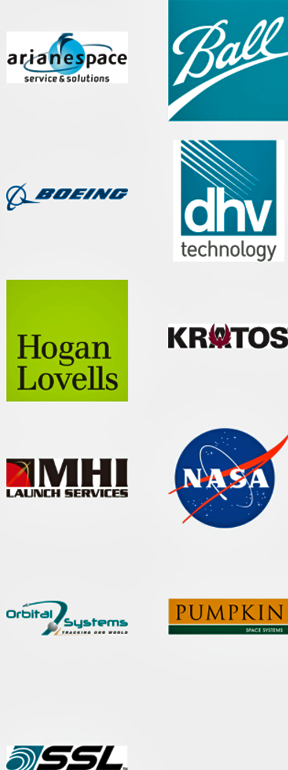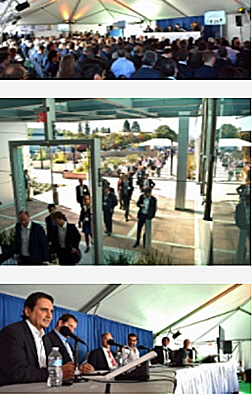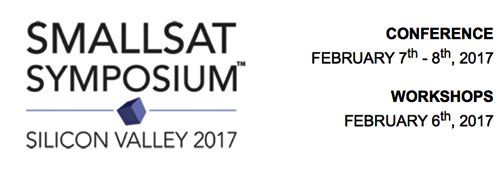With four new workshops and a broad range of thought-provoking panels, give your company the means to maximize growth while minimizing new overhead.
2017 Program
Sessions:
The State of the Small Satellite Industry
Today's small satellite industry demands sound business and financial practices. How do we best cultivate dependable practices? Panelists explore the various types of small satellites (Nano, Pico, Cube, Etc.), their leading applications, as well as trending uses in each subset. How do we define the small satellite marketplace and what is its size? How much new growth can come from small satellites and which segments and markets represent the greatest opportunities? What “traditional” types of capacity and services are changed by the growth in small satellites? Importantly, how do small satellites affect the satellite market as a whole?
Financing Small Satellite Operations
Investment in small satellite ventures originates from a variety of avenues including angel investors, venture funds, private equity firms, corporations, commercial banks and public markets. How do the varying demands of each of these financiers affect small satellite operations and planning? What are their expected returns and financing terms? What are the most important criteria investors look for in choosing ventures to fund? How much of a role does private equity activity and debt financing play in funding SmallSat operations and what effect does this have on management behavior? Panelists will discuss how different types of investors perceive the small satellite industry.

Launch Provider Roundtable — Efficiency, Risk and Trends
Launching any satellite is inherently a risky and expensive business. Multiple new launch options are being created that offer opportunity to minimize risk and reduce costs. Executives from commercial launch service providers will share their views on current market trends and on their strategies to deliver the most adapted solutions for the launch of small satellites. How will new innovations, launch availability, changes in satellite designs and durability in small satellite design alter the future of the launch sector? What is the impact of re-usable engines on future launch costs? Which propellants, engines, components and new technologies are the launch sector investing in? What are the game changers? Panelists will discuss strategies for funding launch operations and the time it takes to book a flight.
Ground Systems Economics and Architecture
As hundreds of new small satellites are launched, ground systems must keep pace to track and communicate with them. What will be the increasing demands for these systems, as well as new autonomous onboard TT&C developments mean for the ground system market? What are the most important criteria in selecting ground system architecture for small satellites? What current and recent trends might change market dynamics in the future?
Pricing and Marketing SmallSat Services
Disruptive innovations create new markets. Business development executives will present their views on market opportunities and where to sell the multitude of products that have resulted from the SmallSat revolution? The collision of finance and technology has produced both turbulent markets and spectacular innovations. Who has bought, who will buy, and what will they pay? More importantly, how should products be priced to maximize revenue?
Cost Savings in Small Satellite Alternatives
How do small satellite alternatives compare to older technologies? Panelists will discuss foremost applications where cost savings are changing paradigms. The focus will be on different development models, prototypes and early operations including the overall positioning, level of vertical integration and cooperation with other industry stakeholders. Also under discussion will be budgetary considerations unique to the small satellite platform.
Small Satellite Constellation Dynamics
As small satellites spread across the skies, questions about constellation management arise. What is involved in designing, implementing and maintaining multiple satellites in a small satellite constellation? What parts of the basic principles of the ITU Article 5 and what timelines and notifications are applicable? How does operating a small satellite constellation differ for a more traditional satellite system? What are the most important applications flying in constellations today and what might they be tomorrow?

Earth Observation
With more than 400 Earth Observation (EO) satellites (50kg+) planned for launch by 2025, and an additional 1000 satellites below 50k flying in constellations, the coming decade of growth in observation satellites is enormous. From agriculture and mining to traffic observation, mapping and weather, small satellites provide an opportunity to observe our planet in considerable detail. High resolution, accurate data provides a range of solutions to meet the immediate needs of emergency responders, defense users and location-based services. In how many ways can Geospatial Data be presented and be useful? Who are the important customers and what are their primary concerns and requirements?
Securing Capital in New, Small Satellite Ventures
What is the optimal way to secure capital for the startup phase of a SmallSat venture? What are the different dynamics of getting funding for a startup SmallSat operator vs a startup manufacturer/launch service provider or data processing company? Explored in this panel are the various ways capital suppliers view revolutionary ideas. Has the complexity of the financial market led to roadblocks for SmallSat operators and manufacturers? How do operators avoid financial pitfalls (funding gaps, etc.)? Beyond the first funding round, how will investors approach adding capital to a maturing venture? What is the past and present performance of the sector and what are the current and expected trends for industry consolidation and M&A transactions?
Traditional Large Integrators — What is their Role in the SmallSat Industry?
Threat or opportunity? What are the majors doing independently or with their affiliates to capitalize on the SmallSat market? Airbus, Boeing, General Dynamics, Hughes, Lockheed Martin, Northrop Grumman, Raytheon, SSL and Thales Alenia are known for the scale of the systems they implement. How does each approach the small satellite market, and how does the scale of their organizations affect that approach?
Next Generation Technology
What new technologies will fly in the next generation of small satellites? What terrestrial equipment will be necessary to support these innovations? Speakers will discuss potential new applications, private sector technologies, space tech incubators, notable advances in design and implementation, advanced materials, 3D printing and robotics. What will be the role of NASA, NOAA, and Research Universities? What new business models and applications might be enabled by the birth of new technologies?
Defense and Government Applications
Defense, Government and NGO sectors require both remote sensing intelligence to detect and classify objects and also connectivity for secure, mission-critical communications. With advancements in small satellite technology, what kinds of improvements could SmallSat bring to existing solutions? What kinds of innovative new solutions might materialize? How do SmallSat operators work with government partners?
Workshops:
- Legal and Regulatory Roadmap
- The Use of COTS Products in Small Satellites
- Earth Observation – Market Trends
- Earth Observation - Remote Sensing and Geospatial Data – A Technical Analysis
Keynotes:
- Miles O’Brien, Science Correspondent, PBS NewsHour
- Professor Sir Martin Sweeting, Founder and Executive Chairman, Surrey Satellite Technology Ltd.
Early registration rates are now available... please select this direct link for information...


